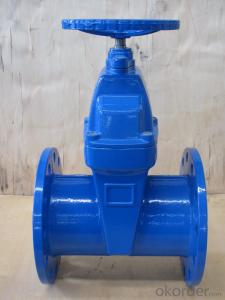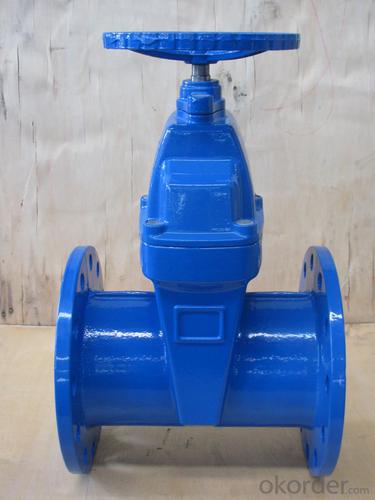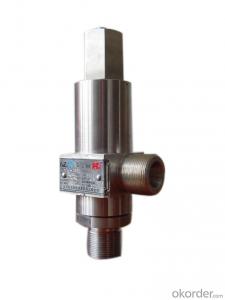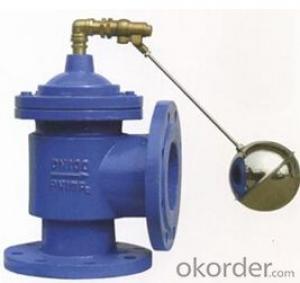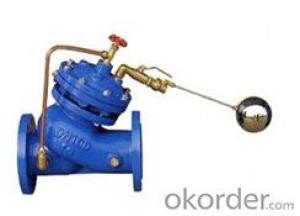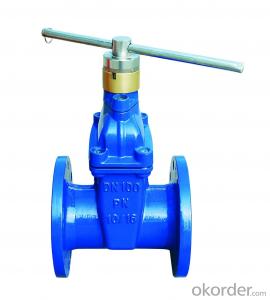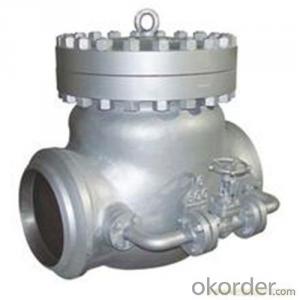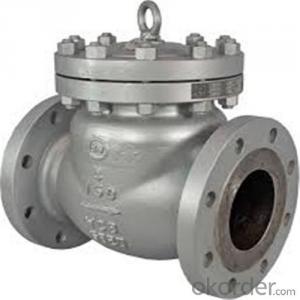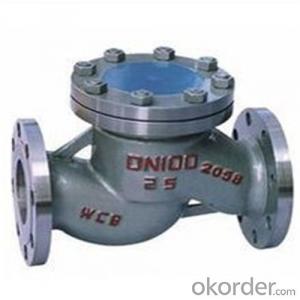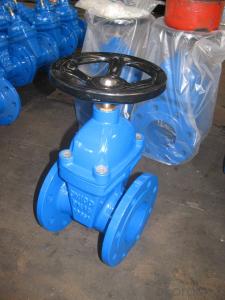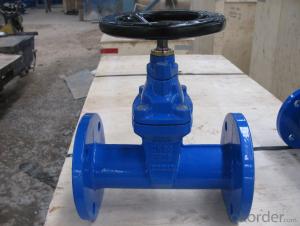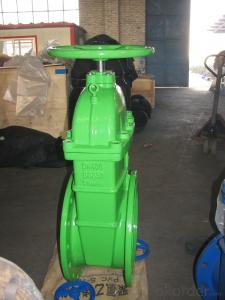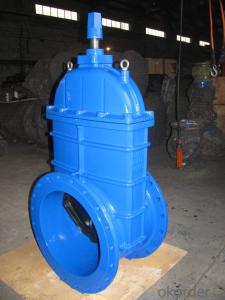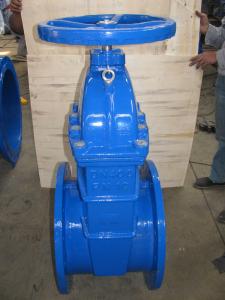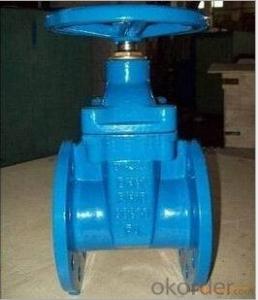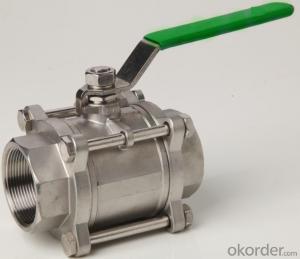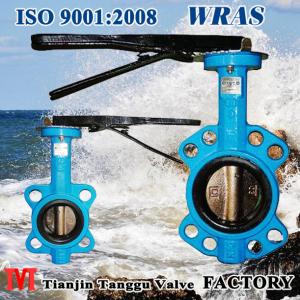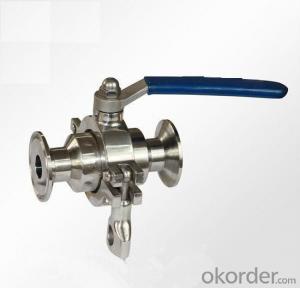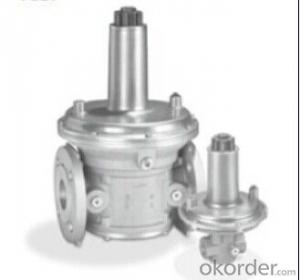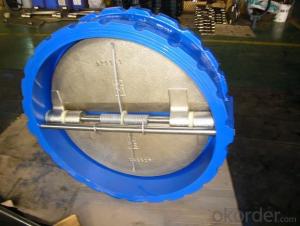Non-rising Stem Resilient Seated Gate Valve F5
- Loading Port:
- China Main Port
- Payment Terms:
- TT OR LC
- Min Order Qty:
- -
- Supply Capability:
- -
OKorder Service Pledge
OKorder Financial Service
You Might Also Like
Type: | Non-Rising Stem |
Material: | Body: Cast Iron / Ductile Iron Wedge: Cast Iron / Ductile Iron Encapsulated with EPDM Seat: EPDM / NBR Shaft: SS410 Stem Nut: Brass O-ring: EPDM, NBR Wedge Nut: Brass / Bronze Hand Wheel: Ductile Iron
|
Operator: | Hand Wheel / Bevel Gearing / Square head / Electric actuator |
Face to Face: |
BS5163: 1986, DIN 3202 F4-F5, JIS B2002, ANSI B16.10
|
Flange: | BS4504, DIN 2532, JIS B2212, ANSI B16.10/ANSI B16.50
|
Working Pressure: | 16 Bar(200 PSI) |
Design and Manufacturer Standard : | BS5163, DIN 3352, JIS B2043 |
Test Standard: | API 598 BS6755 DIN 3230 JIS B2003 |
Application: | Water works, Sewage, Public facilties, Building industry, Petroleum, Chemical, Steel, Metallurgy, Paper Making Industry, Foods, Beverage, HVAC |
| | | | ||||||||
| | | | ||||||||
| | | | ||||||||
| | | | ||||||||
| | | | ||||||||
| | | | ||||||||
| | | | ||||||||
| | | | ||||||||
- Q: I dont want to buy an expensive snorkel, because I only want the valve. Its for a project for a club where I go to college.
- try amazon and OKorder
- Q: heater control valve is leaking
- Do it from underneath. Drain the cooling system and cut the short hose between the heater core and the valve with a sharp knife. Unfasten the actuator cable, loosen the clamp on the heater hose and work the heater hose off it. Use the sharp knife to slice the remains of the short hose off the heater core... be gentle because the soft pipe is easily deforned (which is why you must not try to wrench it off). Put a replacement hose on the new valve and reassemble. When you refill the cooling system be sure to purge the air by opening the bleeder nipple on the upper radiator hose housing at the engine until a steady stream of coolant comes out. Watch out for the sharp edge of the catalytic converter shield! I have a scar on my wrist from learning that the hard way. EDIT - I forgot to mention - if the cable seems to be misadjusted on the valve when you are done, remove the passenger side of the console and look at the mixer linkage in there. The cable housings often slip in the clamps.
- Q: Bought a 1986 GMC 350day 1 started up good - idle was rough - idle really too low, when brakes where applied, it would backfire. (day 2) Changed oil which was really dark - oil filter too... ghanged spark plugs and wires. % 10 improvement... Engine lack power and vibrates but no more backfire.day 4 Changed Cap and rotor - % 30 improvement - day 5 Got the manifold gasket replaced. Same condition but silent... day 6 Changed coil in cap ... Changed fuel filter % 60 improvement... The thing ran like new... Full power I started beliving again..Got full oil pressure 300 kpa - no valve noise Ran 30 minutes on highway.... Valves started making noise especially on driver's side... Engine lost lots of power, and vibrates a lot... doesnt heat up to much but oil pressure seems very low. (day 7) Start up the thing, and even when cold and choke on, oil pressure not as good as in the beginning. What went wrong
- What went wrong? Bought a 1986 GMC 350. Solution? (day 8) buy a Ford
- Q: Mostly suction apparatus with dual head motor, consist a non-return valve, what is its function to have it on the apparatus and not to have it?
- Non return helps to prevent flow back of the material needed for trasportation,also helps to prevent material to be lost when the motor is turned off,ensures maximam flow. Not to have reason all liquid intedend for transportation will flow back when motor is turned off,difficult to ressit materiall in vertical direction.
- Q: I'm drawing a complete diagram of the heart, but I'm unsure of the positions of the different valves. I know there are the pulmoary valve, the aortic valve, tricuspid/right AV, bicuspid/left AV, semilunar valves, mitral...but I know there are several names for some of them, like I think the mitral and the bicuspid are the same...but there are so many sources online I don't know which to believe. If anyone knows for absolute sure the right names and where they are it would be very appreciated if you could help :)
- the bicuspid is the same as the mitral valve it seems like anatomy has 12 names for everything In anatomy, the heart valves maintain the unidirectional flow of blood in the heart by opening and closing depending on the difference in pressure on each side. They are mechanically similar to reed valves. There are four valves in the heart (not counting the valve of the coronary sinus, and the valve of the inferior vena cava): The two atrioventricular (AV) valves between the atria and the ventricles, also called tricuspid and bicuspid. The two semilunar (SL) valves, in the arteries leaving the heart, also called pulmonary and aortic. This I know for sure. Drawing pictures always helped me keep it straight and I just got an A in anatomy. best of luck to you
- Q: What exactly are valves and cylinders when talking about car engines? Say a car has 3 cylinders or 8 valves for example.
- There are intake valves and exhaust valves. On the intake side, the intake valve opens which lets the fuel/air mixture into the combusion chamber. At some point (measured in degrees of crank rotation) the intake valve closes, the air/fuel mixture is compressed and ignited by the spark plug. Then the spent mixture exits the cylinder when the exhaust valve opens. Valve configuration varies somewhat, but regardless of how many valves there are there will always be at least one intake and one exhaust valve. Some cylinder heads have 2 intake and 2 exhaust valves which is what is described as the 4-valve per cylinder setup. Regarding Car Cylinders, the answerer says Cylinders in a car engine are pretty much like rowers in a boat. But they are not. Rowers always row in synch with each other. Cylinders are made to be out-of-sync for smoother operation. The more cylinders you have, the smoother the engine runs. Compare a 1-cylinder minibike with a 4-cylinder motorcycle (both air-cooled), or a 4-cylinder to an eight... big difference in smoothness.
- Q: Ok, so I was just wondering, do you have to have a turbo to get blow-off valves? Also, do you have to have a manual? And are there any other requirements?
- I'm a girl.....you don't have to have a turbo, any type of fast car will get you blown off.
- Q: behind the valve cover of the #1 and #2 cylinder there are 2 intake and 2 exhaust valves I need know (cylinder #1) which is the intake and which is the exhaust. thank you in advance.
- The intake valves are the two rocker arms in the center of the passenger-side head. The exhaust valves are the rocker arms on either end of the head. For the #1 cylinder, the exhaust valve is the one closest to the flywheel side of the engine, and the intake valve is the next one towards the rear of the car. For example, if you're underneath the car and looking at the head, this is the pattern: Ex #2, In #2, In #1, Ex #1.
- Q: I pulled the vaccuum line off the valve and nothing happened. I revved the engine and held it a higher rpm and still nothing happened(no vaccuum). Does this mean that the egr valve is bad. I have been having a problem with rough idle, and keeping the car running at a stop sign. I have already changed the pcv valve and that seemed to help a little. Thanks
- You have likely got a bit of carbon in the EGR that you can clean after you remove it, I usually spray some penetrating oil into the valve hold my finger over the hole that I sprayed into and turn the valve over, if it leaks the seat is dirty and cleaning the carbon out may help. also push up on the plunger several times to be sure that it doesn't stick alternate carb cleaner with penetrating oil until the valve is free and no longer leaks when inverted. As far as your question the test you described doesn't test the EGR or the EGR solenoid correctly at all. On some the car needs to be in gear to actuate the EGR, all you need to do is check that there is vacuum to the solenoid and that the EGR valve works freely. If the EGR fails to work the check engine light should be on and you can check the code to get a clue as to why.
- Q: Does anyone know what those valves are/do in my picture?http://img223.imageshack.us/my.php?image=dsc00531it9.jpg
- Those are the hot and cold water pipes. You can turn off the water to the handle/knob by adjusting these valves. Although, it may be simpler and quicker to simply turn off the main for the home. This link has some similar examples and dialogue.
Send your message to us
Non-rising Stem Resilient Seated Gate Valve F5
- Loading Port:
- China Main Port
- Payment Terms:
- TT OR LC
- Min Order Qty:
- -
- Supply Capability:
- -
OKorder Service Pledge
OKorder Financial Service
Similar products
Hot products
Hot Searches
Related keywords
